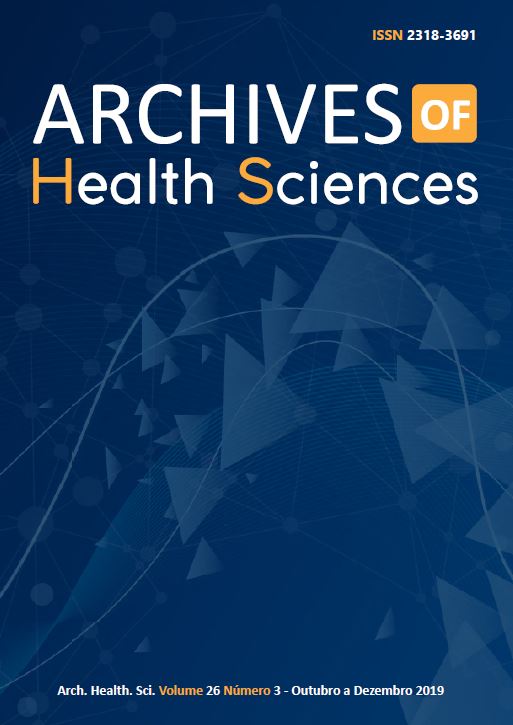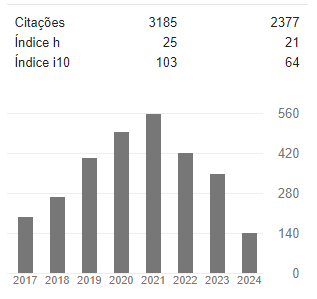Imunohistoquímica na avaliação das doenças inflamatórias intestinais (DII)
DOI:
https://doi.org/10.17696/2318-3691.26.3.2019.1644Palavras-chave:
Doenças crônicas intestinais; Imuno-Histoquímica; Marcadores imuno-histoquímicos; Doenças intestinais; Doença de Crohn; Retocolite ulcerativaResumo
As doenças inflamatórias intestinais são desordens de etiologia idiopática cujo diagnóstico histopatológico é dado por meio de marcadores imunohistoquímicos. Portanto, o objetivo do presente estudo foi revisar os mais recentes ensaios clínicos publicados, que se utilizaram da imunohistoquímica para a avaliação de marcadores úteis no diagnóstico, no tratamento e no acompanhamento de tais doenças. Para isso, realizou-se uma revisão bibliográfica dos trabalhos publicados entre 2014 e 2017, presentes nas bases de dados Pubmed/medline e Cochrane Library, a partir da busca pelos descritores “Inflammatory bowel disease” AND “immunohistochemistry”. Os resultados evidenciaram que MMP-9 e calprotectina fecal são marcadores úteis para o diagnóstico das doenças inflamatórias intestinais. Além disso, as quantificações de TNF, IL-6 e Anti-TNF se mostraram úteis para o acompanhamento desses pacientes, principalmente na verificação de melhora ou piora do quadro clínico após a instituição da terapia farmacológica. Concluiu-se, então, que a imunohistoquímica é uma metodologia bastante promissora para a avaliação das DII e, por isso, mais pesquisas que visem a descobertas de outros marcadores e que contribuam para o cuidado desses pacientes devem ser estimuladas.
Referências
Valdovinos-García R, Martínez-Vázquez M. Diagnostic approach to inflammatory bowel disease. IBD Reviews. 2018;4:30-8.
Wehkamp J, Götz M, Herrlinger K, Steurer W, Stange EF. Inflammatory bowel disease: crohn’s disease and ulcerative colitis. Dtsch Arztebl Int. 2016;113:72-82. DOI: 10.3238/arztebl.2016.0072
Ko J, Auyeung K. Inflammatory bowel disease: etiology, pathogenesis and current therapy. Curr Pharm Des. 2014;20(7):1082-96. DOI: 10.2174/13816128113199990416
Hanauer, S B. Inflammatory bowel disease: epidemiology, pathogenesis, and therapeutic opportunities. Inflamm Bowel Dis. 2006;12(5):S3-S9. DOI: 10.1097/01.mib.0000195385.19268.68
Su HJ, Chiu YT, Chiu CT, Lin YC, Wang CY, Hsieh JY, et al. Inflammatory bowel disease and its treatment in 2018: Global and Taiwanesestatus updates. J Formos Med Assoc. 2019;118(7):1083-92. doi: 10.1016/j.jfma.2018.07.005
Mikov MM, Stojančević MP, Bojić GM. Probiotics as a promising treatment for inflammatory bowel disease. Hospl Pharmacol. 2014;1(1):52-60. DOI: 10.5937/hpimj1401052M
Khor B, Gardet A, Xavier R J. Genetics and pathogenesis of inflammatory bowel disease. Nature. 2011;474(7351):307-17. doi: 10.1038/nature10209
1. Xie H, Xiao S, Pai R, Jiang W, Shadrach B, Carver P, et al. Diagnostic utility of TP53 and cytokeratin 7 immunohistochemistry in idiopathic inflammatory bowel disease-associated neoplasia. Mod Pathol. 2013;27(2):303-13. doi: 10.1038/modpathol.2013.133
Dabbs D J. Diagnostic Immunohistochemistry [livro eletrônico]. Elsevier Health Sciences, 2013 [acesso em ano Mes dia]. Disponível em: ???
Gomollón F, Dignass A, Annese V, Tilg H, Gert Van Assche GV, Lindsay JO, et al. 3rd European Evidence-based Consensus on the diagnosis and management of crohn’s disease 2016: Part 1: Diagnosis and Medical Management. J Crohns Colitis 2017;11(1):3-25. https://doi.org/10.1093/ecco-jcc/jjw168
Magro F, Gionchetti P, Eliakim R, Ardizzone S, Armuzzi A, Barreiro-de Acosta M, et al. Third European Evidence-based Consensus on diagnosis and management of ulcerative colitis. Part 1: Definitions, Diagnosis, extra-intestinal manifestations, pregnancy, cancer surveillance, surgery, and ileo-anal pouch disorders. J Crohns Colitis. 2017;11(6):649-70. https://doi.org/10.1093/ecco-jcc/jjx008
Hartman D, Lemos B, Erlich E, Patel R, Kim S, Tracey D, et al. P-103 modulation of inflammatory and disease biomarkers following 4 week treatment with AVX-470, an Oral Anti-TNF Antibody, in ulcerative colitis patients. Inflamm Bowel Dis. 2014;20(Supl1):S69-S70. https://doi.org/10.1097/01.MIB.0000456856.72564.82
Hartman DS, Tracey DE, Lemos BR, Erlich EC, Burton RE, Keane DM, et al. Effects of AVX-470, an oral, locally acting anti-tumour necrosis factor antibody, on tissue biomarkers in patients with active ulcerative colitis. J Crohns Colitis. 2016;10(6):641-9. doi: 10.1093/ecco-jcc/jjw026
Atreya R, Neumann H, Neufert C, Waldner MJ, Billmeier U, Zopf Y, et al. In vivo imaging using fluorescent antibodies to tumor necrosis factor predicts therapeutic response in Crohn’s disease. Nat Med. 2014;20(3):313-8. doi: 10.1038/nm.3462
Steenholdt C, Coskun M, Buhl S, Bendtzen K, Ainsworth MA, Brynskov, J et al. Circulating cytokines and cytokine receptors in infliximab treatment failure due to TNF-α independent crohn disease. Medicine (Baltimore). 2016;95(16):e3417. doi: 10.1097/MD.0000000000003417
Brandse JF, Van den Brink GR, Wildenberg ME, Van der Kleij D, Rispens T, Jansen JM, et al. Loss of infliximab into feces is associated with lack of response to therapy in patients with severe ulcerative colitis. Gastroenterol. 2015;149(2):350-5.e2. doi: 10.1053/j.gastro.2015.04.016
Steenholdt C, Bendtzen K, Brynskov J, Thomsen O, Ainsworth MA. Clinical implications of measuring drug and anti-drug antibodies by different assays when optimizing infliximab treatment failure in Crohn’s disease: post hoc analysis of a randomized controlled trial. Am J Gastroenterol. 2014;109(7):1055-64. doi: 10.1038/ajg.2014.106
Bruyn M, Machiels K, Vandooren J, Lemmens B, Van Lommel L, Breynaert C, et al. Infliximab restores the dysfunctional matrix remodeling protein and growth factor gene expression in patients with inflammatory bowel disease. Inflamm Bowel Dis. 2014;20(2):339-52. doi: 10.1097/01.MIB.0000438430.15553.90
Bruyn M, Arijs I, De Hertogh G, Ferrante M, Van Assche G, Rutgeerts P, et al. Serum neutrophil gelatinase B-associated lipocalin and matrix metalloproteinase-9 complex as a surrogate marker for mucosal healing in patients with Crohn’s disease. J Crohns Colitis. 2015;9(12):1079-87. doi: 10.1093/ecco-jcc/jjv148
Farkas K, Saródi Z, Bálint A, Földesi I, Tiszlavicz L, Szűcs M, et al. The diagnostic value of a new fecal marker, matrix metalloprotease-9, in different types of inflammatory bowel diseases. J Crohns Colitis. 2015;9(3):231-7. https://doi.org/10.1093/ecco-jcc/jjv005
Molander P, Färkkilä M, Ristimäki A, Salminen K, Kemppainen H, Blomster T, et al. Does fecal calprotectin predict short-term relapse after stopping TNFα-blocking agents in inflammatory bowel disease patients in deep remission? J Crohns Colitis. 2015;9(1):33-40. doi: 10.1016/j.crohns.2014.06.012
Mirsepasi-Lauridsen HC, Bachmann Holmetoft U, Ingdam Halkjær S, Angeliki Krogfelt K, Munk Petersen A. Comparison of three commercial fecal calprotectin ELISA test kits used in patients with inflammatory bowel disease. Scand J Gastroenterol. 2016;51(2):211-7. doi: 10.3109/00365521.2015.1081399
Vinding KK, Elsberg H, Thorkilgaard T, Belard E, Pedersen N, Elkjaer M, et al. Fecal calprotectin measured by patients at home using smartphones—a new clinical tool in monitoring patients with inflammatory bowel disease. Inflamm Bowel Dis. 2016;22(2):336-44. doi: 10.1097/MIB.0000000000000619
Franzè E, Marafini I, De Simone V, Monteleone I, Caprioli F, Colantoni A, et al. Interleukin-34 induces Cc-chemokine ligand 20 in gut epithelial cells. J Crohns Colitis. 2016;10(1):87-94. doi: 10.1093/ecco-jcc/jjv181
Khare V, Dammann K, Asboth M, Krnjic A, Jambrich M, Gasche C. Overexpression of PAK1 promotes cell survival in inflammatory bowel diseases and colitis-associated cancer. Inflamm Bowel Dis. 2015;21(2):287-96. doi: 10.1097/MIB.0000000000000281
Dinallo V, Di Fusco D, Laudisi F, Marafini I, Monteleone I, Monteleone G. OC.02.1 high expression Of DUBA, a regulator of T cell activation, in inflammatory bowel disease. Dig Liver Dis. 2016;48(Supl2):e75. DOI: https://doi.org/10.1016/S1590-8658(16)30022-6
Papp M, Sipeki N, Tornai T, Altorjay I, Norman GL, Shums Z, et al. Rediscovery of the anti-pancreatic antibodies and evaluation of their prognostic value in a prospective clinical cohort of Crohn’s patients: the importance of specific target antigens (GP2 and CUZD1). J Crohns Colitis. 2015;9(8):659-68. doi: 10.1093/ecco-jcc/jjv087
Gensollen T, Bourges C, Rihet P, Rostan A, Millet V, Noguchi T, et al. Functional polymorphisms in the regulatory regions of the VNN1 gene are associated with susceptibility to inflammatory bowel diseases. Inflamm Bowel Dis. 2013;19(11):2315-25. doi: 10.1097/MIB.0b013e3182a32b03
Thörn M, Rorsman F, Rönnblom A, Sangfelt P, Wanders A, Eriksson BM, et al. Active cytomegalovirus infection diagnosed by real-time PCR in patients with inflammatory bowel disease: a prospective, controlled observational study. Scand J Gastroenterol. 2016;51(9):1075-80. doi: 10.3109/00365521.2016.1156154
Shang HX, Wang AQ, Bao CH, Wu HG, Chen WF, Wu LY, et al. Moxibustion combined with acupuncture increases tight junction protein expression in Crohn’s disease patients. World J Gastroenterol. 2015;21(16):4986-96. doi: 10.3748/wjg.v21.i16.4986
Desai D, Faubion WA, Sandborn WJ. Review article: biological activity markers in inflammatory bowel disease. Aliment Pharmacol Ther. 2007;25(3):247-55. DOI: 10.1111/j.1365-2036.2006.03184.x
Hanauer SB, Sandborn WJ, Rutgeerts P, Fedorak RN, Lukas M, MacIntosh D, et al. Human anti–tumor necrosis factor monoclonal antibody (adalimumab) in Crohn’s disease: the CLASSIC-I Trial. Gastroenterol. 2006;130(2):323-33. DOI: 10.1053/j.gastro.2005.11.030
Steenholdt C, Bendtzen K, Brynskov J, Thomsen O, Munck LK, Christensen LA, et al. Changes in serum trough levels of infliximab during treatment intensification but not in anti-infliximab antibody detection are associated with clinical outcomes after therapeutic failure in Crohn’s disease. J Crohn Colitis. 2015;9(3):238-45. doi: 10.1093/ecco-jcc/jjv004
Danese S, Vermeire S, Hellstern P, Panaccione R, Rogler G, Fraser G, et al. Results of ANDANTE, a randomised clinical study with an anti-IL6 antibody (PF-04236921) in subjects with Crohn’s disease who are antitumour necrosis factor inadequate responders. J Crohn Colitis. 2016;10(Supl1):S12-S13. https://doi.org/10.1093/ecco-jcc/jjw019.014
Kapel N, Meillet D, Favennec L, Magne D, Raichvarg D, Gobert JG, et al. Evaluation of intestinal clearance and faecal excretion of α1-antiproteinase and immunoglobulins during Crohn’s disease and ulcerative colitis. Eur J Clin Chem Clin Biochem. 1992;30(4):197-202. DOI: 10.1515/cclm.1992.30.4.197
Kubben FJ, Sier CF, Hawinkels LJ, Tschesche H, Van Duijn W, Zuidwijk K, et al. Clinical evidence for a protective role of lipocalin-2 against MMP-9 autodegradation and the impact for gastric cancer. Eur J Cancer. 2007;43(12):1869-76. DOI: 10.1016/j.ejca.2007.05.013
Roggenbuck D, Reinhold D, Werner L, Schierack P, Bogdanos DP, Conrad K. Glycoprotein 2 antibodies in Crohn’s disease. Adv Clin Chem, 2013;60:187-208. DOI: 10.1016/b978-0-12-407681-5.00006-4
Downloads
Publicado
Edição
Seção
Licença

Este trabalho está licenciado sob uma licença Creative Commons Attribution-NonCommercial-NoDerivatives 4.0 International License.











